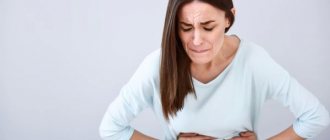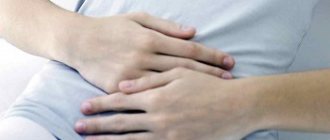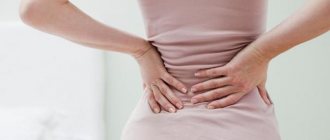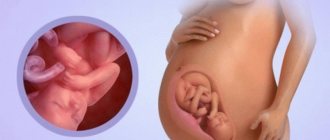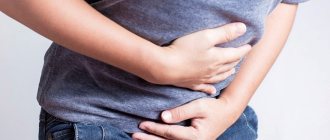Our ancestors determined the onset of pregnancy using folk signs. Accurate diagnosis of successful conception appeared only in the early 60s of the last century. The author of the now popular rapid test that measures the level of hCG in urine was the German scientist Sondek. And what signs of pregnancy will allow the expectant mother to guess about the birth of a new life without diagnosis?
When to worry
A woman is not able to determine without the help of a doctor that the symptoms that arise are related to ovulation. Pain can be caused by ectopic pregnancy, appendicitis, ruptured cyst, inflammation of the ovary, food poisoning and other diseases. You should consult a doctor if you experience:
- increasing pain in the lower abdomen, especially accompanied by a positive Shchetkin-Blumberg test (when pressing on the abdomen, the pain is weaker than when releasing the hand);
- nausea, vomiting, stool disorders;
- fever, chills;
- duration of unpleasant symptoms exceeding 48 hours;
- severe headache, accompanied by dizziness and surges in blood pressure;
- painful urination;
- heavy bleeding
- discharge of blood clots;
- the appearance of copious foul-smelling discharge from the genital tract.
To make a diagnosis, a gynecologist examines the patient, takes smears, and prescribes an ultrasound of the pelvic organs. Only after undergoing an examination can a woman calm down, knowing that her health is not in danger.
How to get rid of abdominal pain during ovulation.
If you find out for sure that this condition is due to ovulation, try to relax, eliminate nervous tension, and maintain a positive attitude. Drink a lot. A warm heating pad on your lower abdomen will also help relieve pain.
However, due to various reasons, pain may begin. It is usually relieved with a single dose of an antispasmodic or analgesic drug.
Do I need treatment?
Only a gynecologist can answer this question after studying the results of tests and examinations. In any case, during pain, it is better to lie in bed, applying a warm heating pad to your stomach. Heat relaxes muscles and reduces pain.
Anti-inflammatory, analgesic and antispasmodic drugs are prescribed as symptomatic drugs. A gentle diet and drinking plenty of fluids are recommended.
If the pain recurs with each ovulation and causes severe discomfort, you should consult a doctor who will prescribe oral contraceptives that inhibit ovulatory function.
Often the disease is accompanied by gynecological pathologies that need to be identified and treated. To do this, you need to make an appointment with a gynecologist and get examined. Sometimes, after eliminating “female” diseases, pain associated with ovulation disappears.
Introduction
Doctors say that not all women feel the onset of ovulation. It would be more correct to say that only 1⁄4 of the beautiful half of humanity feel this process in their body. If, according to your calculations, day “X” has arrived, then you can feel how your lower abdomen hurts during ovulation. You can also feel pain in the side, or discomfort in the stomach, in the lumbar region and anus. Loose stools may appear.
Causes of anovulation
The causes of the anovulatory state are quite varied. As a natural physiological process, the absence of ovulation is typical for pregnant and lactating women. Ovulation disorders may be associated with natural age-related and hormonal changes - the onset of menopause, puberty. The cause of anovulation can be the most basic factors:
- change of climatic conditions , seasons of the year;
- frequent stressful situations , emotional tension;
- avitaminosis;
- intoxication;
- taking antibiotics;
- overweight and underweight;
- excessive physical activity ;
- unhealthy diet (fast food, fatty foods, soda, etc.);
- bad habits (smoking, alcohol, drugs).
In medicine, the absence of ovulation is considered a pathological condition in the diagnosis of infertility and the occurrence of uterine-type bleeding. Anovulation as a pathology of the reproductive system can be associated with the following diseases and disorders:
- ovarian dysfunction;
- hormonal abnormalities (excessive production of prolactin, lack of FSH, incorrect ratio of male and female hormones);
- inflammatory processes in the appendages;
- sexual infections;
- functional changes in the functioning of the thyroid gland;
- oncology;
- genetic pathologies, deviations in the process of puberty.
What to do to relieve pain?
If you feel itchy and painful on the days of expected ovulation, it is advisable to visit a specialist to find out the cause of the pathology. Taking analgesic medications will help reduce discomfort at home. Among them are No-shpu and Spazmalgon. The most effective folk remedies for pain relief include:
- Calendula infusion;
- Melissa;
- Elecampane root;
- Yarrow decoction.
In case of severe pain, it is advisable to limit physical activity and monitor your condition. It is important not to ignore the symptoms that appear. It will help make the correct diagnosis.
If your stomach hurts for physiological reasons, a hot heating pad will help relieve the discomfort. It relaxes muscle spasms. In situations where the pain is due to pathological reasons, a heating pad can worsen the situation.
Should you see a doctor?
As a rule, a woman begins to track her ovulation only when she is planning a pregnancy. The anovulatory cycle is the most common cause of infertility. Therefore, it is imperative to seek qualified medical help from a gynecologist.
Only a doctor can determine the exact cause of the lack of ovulation and develop the optimal treatment regimen to restore sexual function. The gynecologist has all the necessary equipment to fully diagnose the pathological condition. You should not neglect routine examinations with a doctor, because it is quite difficult to suspect such a problem on your own.
The volume of blood lost and the regularity of menstruation during an anovulatory cycle can be the same as during full menstruation. Regular examinations will allow you to identify pathology at an early stage and avoid serious consequences.
Calendar method
This method of determining ovulation is suitable for those who have a regular menstrual cycle. It is 14 days before the start of a new cycle that full ovulation occurs. In order to determine the calendar of days for conception, it is necessary to analyze the last 3 months. The first day of the menstrual cycle is the first day of menstruation. It is 12–14 days before the start of a new cycle that full ovulation occurs. The cycle changes under the influence of various factors - health status, nervous tension, stress, physical activity, climate change when traveling, and so on.
Diagnosis of anovulatory cycle
If an anovulatory cycle is suspected, the diagnosis of pathology begins with an examination of the patient. To make a final diagnosis, the gynecologist uses the following examination methods (or combinations thereof if necessary):
- Ultrasound examination of the pelvic organs
- during an ultrasound, the gynecologist evaluates the condition of the endometrium, ovaries, the presence of the corpus luteum and fluid. If the cycle is anovulatory, the screen shows immature follicles, thin endometrium, and no fluid; - Rectal temperature measurement
—during the progesterone phase of the menstrual cycle, rectal temperature should increase. If this does not happen, then the dominant follicle does not mature; - Functional tests (uterine mucus stretching method, pupil symptom, fern symptom)
- allow you to analyze the process of estrogen production, the volume of which should normally increase during ovulation; - Gynecological curettage
- scraping from the uterus is examined for the presence of secretory pathologies of the endometrium. If violations are identified, then an anovulatory cycle is diagnosed.
Timing of ovulation
It should be noted that different women have a noticeable difference in the timing of ovulation . And even for the same woman, the exact timing of the onset varies from month to month. Some women have extremely irregular cycles. In other cases, cycles may be longer or shorter than the average of 14 days. In rare cases, it happens that in women with a very short cycle, ovulation occurs around the end of the menstrual bleeding period, but in most cases, ovulation occurs quite regularly.
If for one reason or another ovulation does not occur, the endometrial layer in the uterus is thrown out during menstruation. If the fusion of the egg and sperm has occurred, then the cytoplasm of the egg begins to vibrate very strongly, as if the egg is experiencing an orgasm. Sperm penetration is the final stages of egg maturation. All that remains of the sperm is its nucleus, where 23 chromosomes are tightly packed (half the set of a normal cell). The sperm nucleus now quickly approaches the egg nucleus, which also contains 23 chromosomes. The two nuclei slowly touch. Their shells dissolve and their fusion occurs, as a result of which they are divided into pairs and form 46 chromosomes. Of the 23 chromosomes of the sperm, 22 are completely similar to the chromosomes of the egg. They determine all physical characteristics of a person except gender. The remaining pair from the egg always contains an X chromosome, and from the sperm there may be an X or Y chromosome. Thus, if there are 2 XX chromosomes in this set, then a girl will be born, if XY, then a boy.
Treatment of anovulation
The treatment regimen for an anovulatory cycle largely depends on the cause of the development of the pathology. In case of exposure to external factors (lifestyle, nutrition, climate), restoration of the cycle can be achieved in simple ways:
- reduction of physical activity;
- avoidance of stressful situations;
- proper nutrition;
- rejection of bad habits;
- compliance with the daily routine.
The next stage in the treatment of anovulation is taking medications (tablets, injections) to stimulate the ovulation process. The action of the drugs is aimed at stimulating the production of estrogen and endometrial growth, helping in the maturation of follicles and the movement of the egg.
Medicines are taken from the 2nd to 5th day of menstruation, and on the sixth day the reaction to stimulation is monitored using ultrasound. If the reaction is positive and the maturation of the follicle to 20-25 mm is visible, the doctor can stimulate its rupture using hCG drugs. Stimulation of ovulatory processes is a rather dangerous medical practice.
| Consultation with a gynecologist RUB 1,200. Make an appointment | or call +7 Laboratory Ave. 20, bldg. 3 +7 st. Composers, 4 |
It should not be abused - doctors recommend using ovarian stimulation no more than 6 times throughout life. A large number of stimulations are fraught with premature consumption of eggs, the onset of early menopause, and exhaustion of the reproductive system.
Ovulation, conception and gender of the child
Research conducted at the National Institute of Environmental Health Sciences (North Carolina) has shown that not only the actual conception of a child, but also its gender depends on the time of conception in relation to the time of ovulation .
The chance of conception is highest on the day of ovulation and is estimated at approximately 33%. A high probability is also noted on the day before ovulation - 31%, two days before it - 27%. Five days before ovulation the chance of conception is estimated to be 10%, four days before ovulation is 14% and three days before ovulation is 16%. Six days before ovulation and the day after ovulation, the likelihood of conception during sexual intercourse is very low.
If we consider that the average “life expectancy” of sperm is 2-3 days (in rare cases it reaches 5-7 days), and the female egg remains viable for about 12-24 hours, then the maximum duration of the “dangerous” period is 6- 9 days and the “dangerous” period correspond to the phase of slow increase (6-7 days) and rapid decline (1-2 days) before and after the day of ovulation , respectively. Ovulation , as noted above, divides the menstrual cycle into two phases: the follicle maturation phase, which with an average cycle duration is 10-16 days and the luteal phase (corpus luteum phase), which is stable, independent of the duration of the menstrual cycle and is 12- 16 days. The corpus luteum phase refers to the period of absolute infertility; it begins 1-2 days after ovulation and ends with the onset of a new menstruation.

